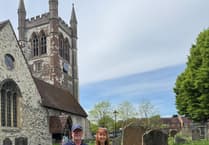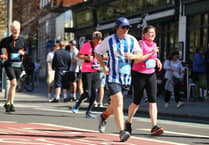One of the oldest houses in Wrecclesham is being given a new lease of life thanks to the Farnham Building Preservation Trust, one of the oldest building preservation trusts in the country, which is celebrating its 50th anniversary this year.
In its 50 years of work, the Farnham Trust has rescued and refurbished many Farnham buildings, often when they were at risk of demolition.
By preserving threatened older buildings large and small, and returning them to a viable present day use, the trust has made a very significant contribution to the Farnham street scene.
In Wrecclesham, Yew Tree Cottage (previously known as Old Yew Tree Cottage) was put on the market in 2015, having been in the same occupancy for over 40 years.
The Farnham Trust is a registered charity and was able to purchase it and embark on an extensive and much-needed restoration and refurbishment project which has taken three years.
The work is due to be completed in August and the property will be offered for sale in the early autumn as a well modernised family home with a sizeable garden and beautiful views across the River Wey valley.
While building work was in progress the Farnham Trust took the opportunity to consult local historians and research the history and construction of the house, the oldest part of which has been accurately tree-ring dated to 1561.
The site on which the house stands is however a lot older, as records show that in 1282 there was an earlier building with six acres of land known as Hughe’s there which had been inherited by Hugh Weylot.
In the early 15th century that house was purchased by William Atte Hulde, a carpenter working for the Bishop of Winchester in Farnham Park and it remained in the same family ownership until 1661.
The first part of the present building replaced the older one in 1561, when it was owned by William Atte Hulde’s descendant Joan Browne.
Yew Tree Cottage is believed to be the birthplace of the famous 19th century professional cricketer ‘Silver Billy’ Beldham, who was selected by The Times in 1997 as one of the 100 greatest cricketers of all time.
Records seem to confirm the claim, as they show that from 1750 to 1811 Yew Tree Cottage was occupied by George Beldham, and Billy was born in 1766. From 1811 to 1820 the house was occupied by William Beldham.
Billy Beldham’s cricketing career spanned 39 years, during which he played for Surrey, Hampshire and All England as well as local Gentry teams.
The Cricketers pub on the corner of School Hill (now Indian restaurant The Bengal Lounge) had for many years a pub sign with a portrait of Silver Billy which has recently been rescued by the Wrecclesham History Project and re-erected behind Yew Tree Cottage next to the recreation ground.
A more recent well-known resident, in the 1960s, was WF Rankine, archaeologist and headteacher at Churt and Badshot Lea. He was a respected archaeologist who researched and published widely on the Mesolithic period in Surrey and Hampshire.
The building work opened up, for the first time, a unique opportunity to make a fully accurate and detailed record of the roof timbers of the house, because the whole roof had to be stripped and re-tiled due to damp.
The Farnham Trust invited the Domestic Buildings Research Group, which had previously inspected the building in the 1970s but had not been able to prepare a full record, to do a much more thorough inspection, as a result of which their earlier report will be completely re-written.
This important project is an appropriate climax to the Farnham trust’s record of 50 years working in and around Farnham.
The trust was founded in 1968 by Sir John Verney, Bt., who was a conservationist before such a thing was fashionable, and Richard Dufty, Fellow of the Society of Antiquarians who was responsible for the rescue and refurbishment as a museum of William Morris’s house in Lechlade.
In the 1960s Sir John had been concerned that there was a need in Farnham for an organisation able to undertake active restoration work, rescuing buildings large and small when their future was under threat, and this was the motivation behind the creation of the Farnham Trust.
When the Farnham Maltings was at risk of demolition in 1969, the newly formed trust was able to obtain loans, raising £10,000 to add to the £20,000 which had already been raised by the people of Farnham towards Courage Brewery’s asking price of £30,000.
The trust bought the Maltings cottages in Bridge Square including the late 15th century Tanyard House, and restored or sold them.
Other early projects were the saving from demolition of the two little stone built Church Cottages, the old headmaster’s and headmistress’s houses at St Andrew’s School, and Cemetery Lodge in West Street, all built in the neo-Gothic style in the late 19th century.
Many notable local buildings followed, including the New Ashgate Gallery, No.31 Lower Church Lane, and the Farnham Pottery in Wrecclesham, as well as smaller projects.
Yew Tree Cottage has been restored using traditional building materials and techniques, with a sympathetically designed extension.
The works have created a unique five-bedroom, three-bathroom family home, and while period features have been retained, the house has been brought into the 21st century offering improved and comfortable modern living.
It will shortly be offered for sale exclusively by Andrew Lodge Estate Agents, who are seeking expressions of interest for viewings in September, when there will also be an open day.
Martin Lloyd, chairman of the Farnham Trust, said: “The trust is proud to be celebrating its 50th birthday with such an important project.”
For more information about The Farnham Building Preservation Trust, visit www.farnhamtrust.org.uk or email [email protected].




.jpg?width=209&height=140&crop=209:145,smart&quality=75)